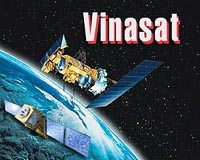 |
Paris (AFP) Oct 6, 2010 The European Space Agency (ESA) said on Wednesday that it had launched a behind-the-scenes campaign to shut down illicit radio and TV transmissions interfering with a major climate satellite. The 315-million-euro (434-million-dollar) Soil Moisture and Ocean Salinity (SMOS) probe "has been bugged by patches of interference from radar, TV and radio transmissions in what should be a protected band," ESA complained. "Painstaking efforts to reduce these unwanted signals are now paying off," the Paris-based agency said. SMOS orbits 760 kilometres (470 miles) above Earth, a low-altitude slot enabling it to gauge the impact of climate change on the movement of water across land, air and sea. Soon after launch last November 2, scientists realised that interference was "effectively blinding" the probe as it passed over parts of southern Europe, Asia, the Middle East and some coastal zones, ESA said in a press release. The intrusion has two causes. One is a leakover into a band of the electromagnetic spectrum (1400-1427 MHz in the L-band) which is assigned to space astronomy and Earth exploration satellites by the International Telecommunications Union (ITU). This source came from overpowerful transmitters in adjacent bands, ESA said. The other cause is illegal transmissions by TV, radio links and networks such as security systems that are blasting into the precious radio band. "Also, terrestrial radars appear to cause interference," ESA said. The agency said it had had to embark upon "the tricky and lengthy process" of having the illegal transmissions shut down and the excessive out-of-band emissions reduced. Its first approach had been to governments in Europe, which were tracking down the sources and having the devices retuned or shut down. As a result, interference "is on the wane," it said. The problem with SMOS has run in parallel with a hitch with the satellite's sister, a probe called Gravity field and steady-state Ocean Circulation Explorer (GOCE). For three months this year, GOCE was able to record data but was unable to send it back to Earth, due to a malfunctioning communications link between the processor and telemetry modules on the satellite's main computer. The ESA announced on September 7 that the problem had been fixed. GOCE and SMOS are on the agency's roster of "Earth Explorer" projects to further fundamental understanding about the Earth. Investigations into ice cover, cloud cover, vertical winds and the planet's magnetic field are either planned or in operation.
Share This Article With Planet Earth
Related Links Space Technology News - Applications and Research
 Integral Systems Expands Satellite Command And Control System For VINASAT Fleet
Integral Systems Expands Satellite Command And Control System For VINASAT FleetColumbia MD (SPX) Oct 05, 2010 Integral Systems has announced at the 2010 Asia-Pacific Satellite Communications Council (APSCC) Satellite Conference and Exhibition that it has been selected by Lockheed Martin Commercial Space Systems (LMCSS) to provide the primary and backup satellite control systems for the VINASAT-2 satellite. The satellite is currently being built by LMCSS for the Vietnam Posts and Telecommunications ... read more |
|
| The content herein, unless otherwise known to be public domain, are Copyright 1995-2010 - SpaceDaily. AFP and UPI Wire Stories are copyright Agence France-Presse and United Press International. ESA Portal Reports are copyright European Space Agency. All NASA sourced material is public domain. Additional copyrights may apply in whole or part to other bona fide parties. Advertising does not imply endorsement,agreement or approval of any opinions, statements or information provided by SpaceDaily on any Web page published or hosted by SpaceDaily. Privacy Statement |